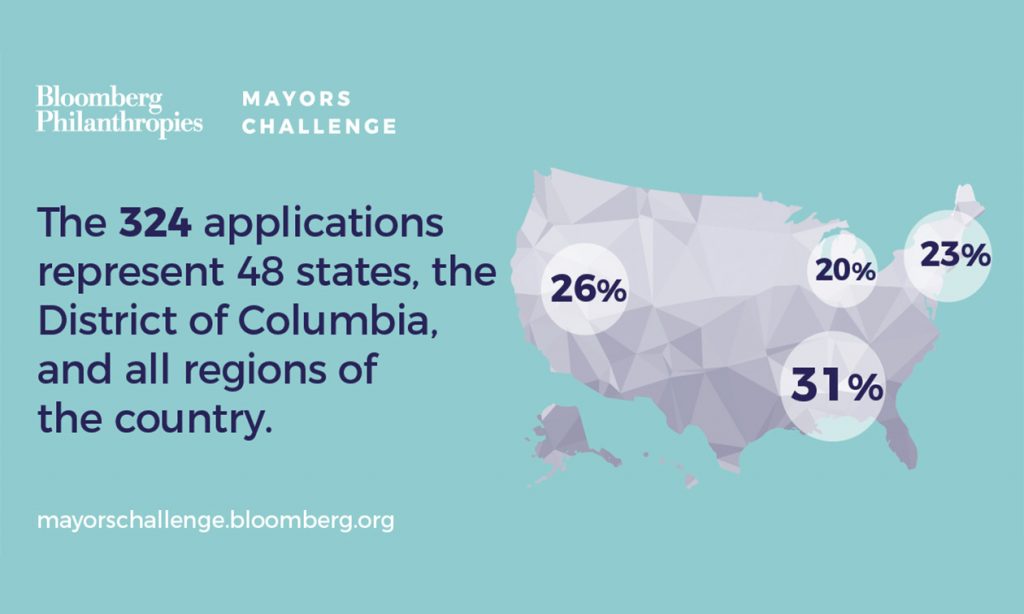324 Mayors Challenge applicants tackle America’s most pressing concerns

By Anne Emig, Bloomberg Philanthropies Government Innovation team
When we announced plans in June for this year’s Mayors Challenge, we set out to do two things: we wanted to bring the Challenge home to where it first started (after successful runs in Europe, and Latin America and the Caribbean) as the first investment in our $200 million American Cities Initiative; and we wanted to give cities the tools and space to tackle their most critical issues.
There’s no question that cities are confronted with mounting pressures, including everything from income inequality and homelessness to failing infrastructure and climate change. What was less clear was – if presented with the shot at $5 million to help them tackle their top concern – what America’s mayors would target.
Today, we’re two steps closer to that answer, with the submission of 324 applications—representing nearly 25 percent of all eligible U.S. cities—and the announcement of our Mayors Challenge selection committee. Co-chaired by Caroline Kennedy, former U.S. ambassador to Japan, and Ursula Burns, retired Chairman and CEO of Xerox, this group of 13 distinguished policy experts, artists, academics, business executives, and social innovation leaders will, over the next year, ensure the most innovative of these applications make it through each stage of the Challenge.
At first glance, the applications reflect what one might expect, including emerging concerns around opioid addiction, urban revitalization, and job training and workforce development. But a deeper dive uncovers more surprising insights, including mayors’ commitment to engaging residents to identify problems, issues that appear to cluster in particular regions, and the variety of unique approaches cities are considering to tackle these concerns.
Some issues attracted more interest in specific regions. For example, 37 percent of the 27 climate-related applications are from the West; 33 percent of the job-related applications are from the Midwest; and 40 percent of the 43 youth-related applications are from the South. Similarly, there were some differences of focus based on city size: 79 percent of those applicants tackling infrastructure issues have fewer than 100,000 residents, while 58 percent of those proposing housing-related ideas have between 100,000 and 500,000 residents. Yet, at the same time, many cities across all regions shared an emphasis on the same problem. In fact, nearly 40 percent of all applications fit within these three categories: health, youth, and citizen engagement.
But what I find most exciting about this year’s Mayors Challenge applications isn’t only the number of problems cities are looking to tackle, but also the vast of array of implementation strategies they’re proposing. While just shy of a third of the cities (27 percent) are looking to digital and/or mobile solutions, the remaining 73 percent are taking dozens of different approaches, including everything from training and infrastructure building to offering financial incentives and gamification. These Mayors Challenge cities are about to solve for our country’s biggest problems while, at the same time, testing, learning, and adapting the best strategies for doing so.
So what’s next? Now that cities have submitted their applications, the heavy lifting shifts to the selection committee, who must narrow the field of 324 down to 35 “Champion Cities.” Once announced early next year, each of these 35 cities will – in a new component introduced with this year’s Challenge – win up to $100,000 to test and refine their ideas for six months. This new testing phase will, in essence, create a coast-to-coast civic-solutions laboratory designed to strengthen all 35 proposals.
As with any competition, this one culminates with the announcement of the winners. Next fall, one $5-million grand prize winner and four $1-million finalists will be unveiled. But if there’s another hope I have for this year’s Mayors Challenge, it’s that it doesn’t end there. Through these 324 applications, America’s cities said loud and clear that they’re ready to innovate. Our challenge, now, will be to continue to find new ways to support them in meeting their goals.